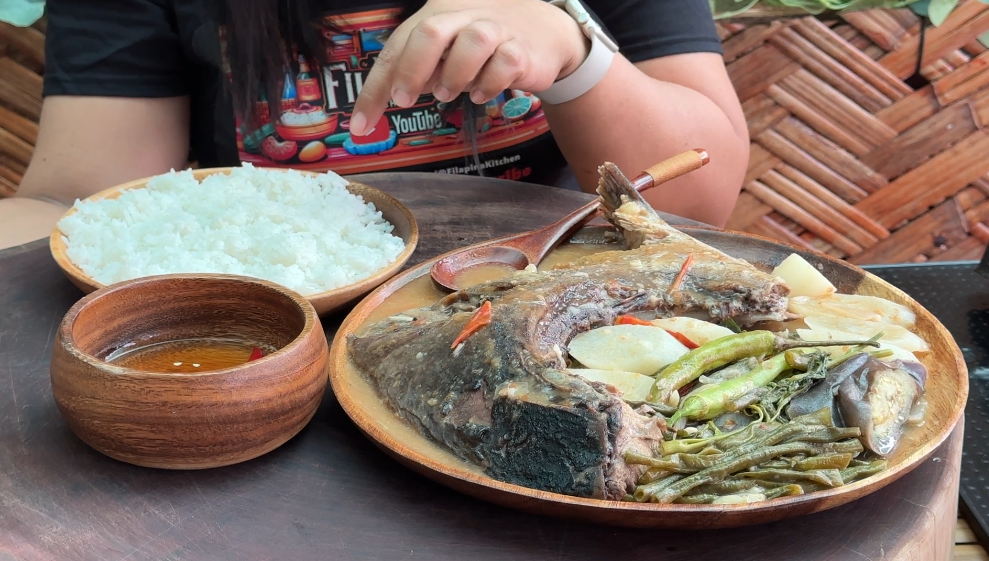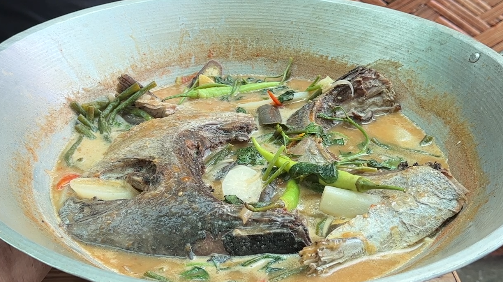Tuna Jaw in Tamarin Soup (Sinigang na Tuna Panga)
Introduction
Tuna Jaw in Tamarind Soup, or Sinigang na Panga ng Tuna, is a beloved Filipino dish known for its hearty, tangy, and savory flavor profile. Sinigang is a hallmark of Filipino cuisine, often hailed as the ultimate comfort food. This version uses tuna jaw (panga ng tuna), prized for its tender meat, gelatinous texture, and rich flavor, making it a luxurious twist on a traditional recipe.
This dish is perfect for rainy days or family meals, offering a bowl of warmth and nostalgia. The sour tamarind broth, combined with fresh vegetables and the soft, flavorful tuna jaw, creates a harmony of flavors that is both refreshing and comforting.
Tuna Jaw in Tamarin Soup (Sinigang na Tuna Panga)
Course: Uncategorized4
servings15
minutes40
minutes180-200
kcalIngredients
1 large tuna jaw (cleaned and cut into pieces)
10 cups water
2 medium tomatoes, quartered
1 large onion, quartered
1 thumb-sized piece of ginger, sliced
1 pack tamarind soup base (sinigang mix) or 1/2 cup fresh tamarind pulp
2 tablespoons fish sauce (patis)
1 medium radish (labanos), sliced thinly
1 bunch kangkong (water spinach), stems separated from leaves
1 medium eggplant, sliced diagonally
2 pieces green chili peppers (siling haba)
Salt and pepper to taste
Directions
- Prepare the Tuna Jaw:
Heat cooking oil in a large pan. Season the tuna jaw with salt and pepper, then fry until golden brown on all sides. Remove from the pan and set aside. - Sauté the Aromatics:
In the same pan, remove excess oil, leaving about 2 tablespoons. Sauté ginger, onions, and tomatoes until fragrant and softened. - Build the Broth:
Pour in water and bring it to a boil. Stir in the tamarind soup base or fresh tamarind pulp. Add fish sauce and let it simmer for about 5 minutes to develop the flavors. - Add the Fried Tuna Jaw:
Gently add the fried tuna jaw into the simmering broth. Let it cook for about 10 minutes, allowing the flavors to meld together. - Add the Vegetables:
Add the radish, eggplant, and okra to the pot. Simmer for another 5 minutes or until the vegetables are tender. Then add the green chilies and kangkong stems. - Finish with Kangkong Leaves:
Stir in the kangkong leaves and simmer for an additional 1–2 minutes. Turn off the heat and let the soup rest for a minute. - Serve:
Ladle the soup into bowls, ensuring each portion has a generous amount of tuna jaw, broth, and vegetables. Serve hot with steamed rice.
Notes
- Things to Remember:
Choose Fresh Tuna Jaw: Freshness is key to the dish’s success. Look for tuna jaw that is bright, has a firm texture, and smells clean without any strong fishy odor. Fresh fish ensures a delicate and flavorful broth.
Prep the Tuna Jaw Properly: Ensure the jaw is cleaned thoroughly and free from blood clots or unwanted bits, as these can affect the flavor of the soup.
Cook the Fish Gently: Overcooking can dry out the tuna jaw, making it tough. Simmer it just until the flesh easily separates from the bone to maintain its tender and juicy texture.
Add Tamarind Gradually: Tamarind’s sourness can overpower the dish if too much is added at once. Taste as you go to find the perfect balance that suits your preference.
Layer Your Ingredients: Add vegetables in the right order—root vegetables first, softer greens last—to ensure everything is cooked perfectly without becoming mushy.
Serve It Fresh and Hot: Sinigang is best enjoyed freshly cooked when the flavors are vibrant and the vegetables retain their texture.
Sinigang is a dish that embodies the Filipino love for bold, comforting flavors. This version featuring tuna jaw (panga ng tuna) takes the classic sour soup to another level. The unique preparation of frying the tuna jaw before adding it to the broth brings an added depth to the dish. The crispy, caramelized edges of the fish enhance its natural umami flavor, while the tender, gelatinous parts absorb the tangy broth beautifully.
The tamarind-based soup creates a signature sourness that perfectly complements the richness of the tuna jaw. Aromatics like ginger, onions, and tomatoes, combined with fresh vegetables such as radish, okra, and kangkong, build layers of flavor and texture, making every spoonful a satisfying bite. The addition of green chilies provides a subtle heat that elevates the dish without overpowering its delicate balance.
This comforting bowl of Tuna Jaw Sinigang is not just about nourishment but also about celebrating the harmony of flavors that Filipino cuisine is known for. It’s a dish that turns simple, fresh ingredients into a heartwarming meal perfect for any occasion.

Do’s and Don’ts
Do’s:
- Do use a clay pot or heavy-bottomed pot: Traditional cookware enhances the flavor and ensures even cooking.
- Do soak the tamarind pulp (if using fresh): If using fresh tamarind, soak it in warm water and strain out the pulp for a natural and authentic sourness.
- Do include green chilies: These add a subtle spice that enhances the dish’s flavor profile without overpowering it.
- Do garnish with fresh herbs: Adding sprigs of fresh cilantro or parsley before serving can elevate the dish’s aroma and presentation.
Don’ts:
- Don’t skip the fish sauce: It adds a depth of umami flavor that’s essential to authentic sinigang.
- Don’t overboil the tamarind base: Prolonged boiling can make the broth cloudy and overly tangy.
- Don’t overcrowd the pot: Overcrowding prevents proper heat circulation, which can leave the fish unevenly cooked.
- Don’t store leftovers too long: Sinigang is best consumed fresh, as the vegetables tend to lose their texture when reheated.
Reasons to Love This Dish
- Bold and Tangy Flavor: The tamarind broth creates a tangy yet refreshing base that awakens your taste buds.
- Rich and Tender Tuna Jaw: The tuna jaw’s gelatinous texture and flavorful meat make it a prized ingredient that elevates this sinigang variant.
- Perfectly Balanced: The interplay of sour tamarind, savory fish sauce, and fresh vegetables creates a dish that feels wholesome and satisfying.
- Versatile Dish: Perfect as a standalone meal or paired with rice, this dish fits any occasion, from casual family dinners to special gatherings.
- A Feast for the Senses: The vibrant colors of the vegetables and the aroma of the tamarind broth make this dish as visually appealing as it is delicious.
Why Is It Healthy?
- Nutrient-Dense Tuna Jaw: Rich in omega-3 fatty acids, tuna jaw supports heart health and brain function. Its gelatinous parts also provide collagen, which is beneficial for skin and joint health.
- Immune-Boosting Tamarind: Tamarind is packed with antioxidants, vitamin C, and anti-inflammatory properties that strengthen immunity and aid digestion.
- Fresh Vegetables: Kang kong, radish, and eggplant are loaded with essential vitamins, minerals, and fiber, supporting overall health and digestion.
- Low in Calories: Despite its bold flavors, this dish is naturally low in calories, making it a healthy option for weight management.
Why You Should Try It
Tuna Jaw in Tamarind Soup is not just a dish; it’s a culinary experience that reflects the warmth and heritage of Filipino cooking. The combination of tangy broth, tender tuna jaw, and fresh vegetables creates a flavor profile that’s truly one-of-a-kind. Whether you’re looking to impress guests or simply enjoy a comforting meal, this sinigang recipe is a delicious and healthy option that everyone will love. Try it today and discover why it’s a staple in Filipino households!
Conclusion
Tuna Jaw in Tamarind Soup is a perfect example of how Filipino cuisine masterfully blends fresh ingredients and bold flavors to create something truly special. The soft, flavorful tuna jaw paired with the tangy tamarind broth makes for an unforgettable dish. Whether it’s a family gathering or a simple weeknight dinner, this Sinigang na Panga ng Tuna is sure to bring comfort and joy to your table. Try Sinigang now!
Click here for more!
